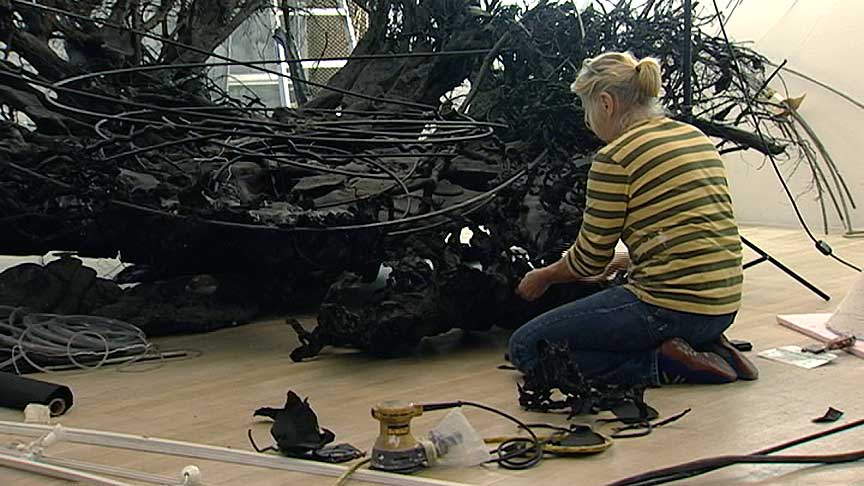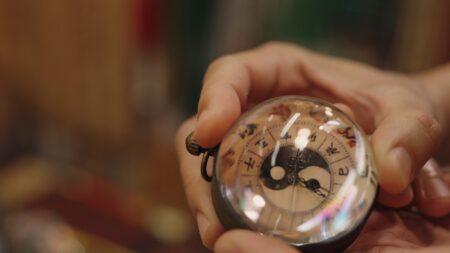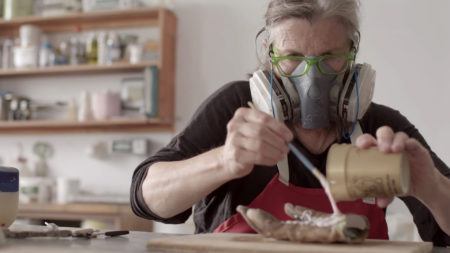Interview
Installation and Drawing

Production still from the "Art in the Twenty-First Century" Season 4 episode, "Romance," 2007. Segment: Judy Pfaff. © Art21, Inc. 2007.
Judy Pfaff discusses her artistic processes and inspirations, as well as the roles that romance, feminism, and environmentalism play in her work.
ART21: Did the feminist movement make an impact on you, as a young artist?
PFAFF: From the early 1970s, there was a lot of talk about feminism. It was a big subject: What is women’s work? What is a female sensibility? There were a lot of things like that, which I didn’t take on. When I was at Cal Arts, I actually inherited the role that Judy Chicago or Mimi Shapiro had there, as The Woman Artist. But what were we doing? What were we talking about?
Linda Nochlin is the most articulate feminist art historian. She wrote something—not particularly about me—but about aspects of what I do. It was something about the chaotic nature of the work—that if a man did it, it would be seen as powerful, like, say, a Jackson Pollock. It would be seen as tough, manly, wild. It would be seen as fighting the dragons, the demons, the dark side—grappling with these things heroically. And if a woman were to handle something like that, it would only be seen as scattered, non-centered, hysterical, flighty. So, the same kind of impulse could be recognized as being very powerful and very flaky. I really liked that conversation. Because when I work, I think most people think it’s just fun. There is so little fun going on that it actually pisses me off. I’m really involved. To have things feel loose takes a sort of thoughtfulness. There’s a rigor in that.
ART21: Did you ever think consciously about what it meant to become an artist?
PFAFF: I just wanted to be an artist, in art. I didn’t want to be original. I didn’t want to be different. I wanted to be in that big family. Because of these new ideas of space and time and the computer and women, that whole Pandora’s box was open. It was my responsibility to make things that had that logic in them. So, I thought making sculpture that was light, transparent, and illusionistic—sculpture that you couldn’t take home and put in your living room, sculpture that had an open-ended aspect—wasn’t just one thing. It was really like a set of experiences or experiments that suggested a larger context. So, that was my job, when I was a kid.
Now, I just do what I do, and I have no rationale for it. But it seemed to me at that moment to be involved, in a funny way, in a feminist orientation. It seemed like the things that had always defined women—their weak points—were now being reevaluated. And I thought that was not only useful, but also that I didn’t like those other things. I was at war with minimalism. I was at war with the single object, with a singular identifying material. It just seemed male to own space, own an idea, own a material.

Production still from the “Art in the Twenty-First Century” Season 4 episode, “Romance,” 2007. Segment: Judy Pfaff. © Art21, Inc. 2007.
ART21: You studied art at both Cal Arts and Yale. What were your experiences like, as a student?
PFAFF: When I went to Yale, there was this division: there were figurative artists, and there were abstract artists. There were men artists, and there were women artists. And since I was an abstract artist studying under Al Held, and not studying under someone like Bill Bailey, there was this enormous dialogue. There was a moment in 1978 when I had this need to make stick figures. And they’re like Russian Constructivist stuff—very simple. Every figure was a person. One was Mike Kelley, and it was painted kelly green. One was Richard Artschwager, and it was made out of rock maple, and it was long and lanky. I think there might have been sixty figures, in one show. But the whole entire time, I was thinking, “I have done it now. Al’s never going to talk to me because they’re figures.” Even though they were like a child’s stick figures, that was sort of like killing the father.
At Cal Arts, they had all of this technology available, which everybody was using to make surfboards and motorcycles. I learned how to weld there, and I learned woodworking, too, but I’m educated as a painter. My undergraduate and graduate degrees are in painting. The only sculpture I ever made was trying to build a loft or put in the plumbing. I was on the West Coast, so I was free of East Coast dogma. And then I inherited West Coast dogma.
ART21: These stick figures are so different from the environmental work you make today. How did you move from one to the other?
PFAFF: I had made three or four shows with these figures. The biggest one was at the Neuberger Museum, which was actually a very good show. I learned a lot, and I’d just gotten an NEA grant. I filled up a space that was one hundred feet by fifty feet—this big space—with little, little things. And then I got known as the person who made those stick figures. Because I don’t take good care of things, they were sort of like toys in the attic—a head was off of one, an arm was off of another. Things were sort of falling apart. And since I knew who everyone was, it was very different than abstraction. I was invited to do a very important show in Houston with Lynda Benglis, Robert Longo, and Jennifer Bartlett; as Robert Longo said, “Three girls and a guy.” It was a big show. This is 1980, and for me, it was the start of my career. I was the whippersnapper, and probably Robert was a whippersnapper too. I had had it with these figures. I couldn’t re-enliven them. They had run their course.
I got through that show, and on the way out, I got a fifty-dollar ticket from Houston to the Yucatan, round trip. I was working night and day, so I was thinking, “Good, I will just go.” And it was only a few days, but I was going to have a vacation. What happened is that it came to me: that when you go to other countries, they don’t have this rhetoric of the New York art world. They don’t see things the same way. Fuchsia is not gauche. Color is not forbidden, not provocative. The birds are colorful, the plants are colorful, all the houses and the plastics in the markets are colored. It’s so delicious, full, and rich and lively. I went snorkeling, and I think there was something about having no gravity—I saw billions of colors missing one another, floating by, things being kind of dangerous. You have to understand: I don’t swim. I don’t climb trees. I don’t do much of anything. But this was an extraordinary experience, snorkeling off of the Yucatan. So, I never did another figure. That was the end of that.
When I came and did my first big show with Holly Solomon, she thought she was going to get a show full of these figures, and she just thought it was hippie art. Instead, she thought I had lost my mind, because I made all of these bundles of organic materials that were made on the roof in Greenpoint, Brooklyn. And with the sun and the wind, they would all roll around. So, I had this ever-changing field of beautiful colors. And then I brought it into the gallery. Holly was a little mortified. And sure enough, the work looked really bad in there, because there was no wind, there was no sunshine. All the good parts, the active ingredients, were left on my roof, and I was stuck in this New York gallery. So, the installation part was actually to pull this stuff back to life—moments of clarifying and directing. From then on, I think I’ve always been that person who does those installations.

Production still from the “Art in the Twenty-First Century” Season 4 episode, “Romance,” 2007. Segment: Judy Pfaff. © Art21, Inc. 2007.
ART21: You say installation like it’s a burden.
PFAFF: The word installation, or the way it’s used now, is like a catchall. If you put three paintings together, it’s now an installation of paintings. It doesn’t seem to mean an awful lot any more. It just sounds very trendy. And lately I actually think it feels so performative that there’s something about the word that I don’t like. It doesn’t feel like what I do. I’ve always made sculpture that relates to architecture or a whole sensation or feeling. And it came with this moniker. But if I think about what an installation is, it’s like, “That’s it.” If you were there between September 7th and October 7th, and you saw this thing, then you saw it, and that’s it. It doesn’t happen again. You can’t redo it. It operates in that gallery on 57th Street, on the second floor, in four spaces, in the autumnal equinox. It’s very specific.
ART21: There seems to be a dark underbelly in a lot of your work.
PFAFF: I think there’s always a melancholy in the work, though everyone has always thought of my work as being very happy, or jaunty, or—what’s that word I get—an explosion in a glitter factory. There’s always something that seemed carefree, easygoing. I can hardly remember that. I mean, I can have a good time, and I can be lighthearted. But there’s another quality that will get in, especially with the latest works. When I look at the old works, when they had the explosive stuff in them, I was just young. So, there were different materials and things, but I think the underpinnings were always quite tight. I would never just put in a red dot here to balance that green dot there. It was always for a funny kind of need, and I always had to know what it was. It was never just formal. It always had to have a storyline.
ART21: What is the relationship between your drawings and your sculptural pieces?
PFAFF: The drawings come before the sculpture. They always have. It’s not the other way around. All the imagery is there. In a funny way, drawing teaches me how to move my hands because the drawings are actually quite physical. They’re cut pieces of paper, or burnt pieces of paper, or stuff stuck on—collages. But they’re very important.
I’m a fast drawer, but I have this thing about skill: it makes me nervous when anything’s too clever. When I am around stuff that’s too loose and too fast, it seems to have too much bravura. So, sculpture slows me down. One of the reasons why I don’t paint anymore is because I was too facile. It was emptier than I wanted it to be, and I couldn’t slow it down.
ART21: When you’re finished with something, like painting, are you afraid to leave it behind you?
PFAFF: I won the painting prize when I was at Yale, which was sort of funny since I’d stopped painting. But I was a talented painter. Remember I said that I never made another stick figure? There was a moment when I was at Yale: it was the second year and I just thought, “I’m never going to make another painting.” And I never have.

Production still from the “Art in the Twenty-First Century” Season 4 episode, “Romance,” 2007. Segment: Judy Pfaff. © Art21, Inc. 2007.
ART21: The drawings are painterly, though.
PFAFF: Now the drawings are painterly, except they’re not on stretched canvas. I know they’re not paintings because paintings make me a little ill when I make them, because I start doing this push-pull thing, this here-there thing. I’m haunted by all of the rhetoric of painting. Elizabeth Murray is a real painter—such a painter! Her paintings are hard work. They’re emotional. They’re direct. She’s not embarrassed. She is there when she paints. She keeps in touch with her life.
I get lost in painting. I can’t be there. With the drawings, the collages, I can come and go. I can do other things. Painters are made differently. They concentrate in different ways, and they get pulled in. What I found, when I was a painter, was that I couldn’t stop. It was like you got sucked in and, until it was finished, another thought didn’t enter. Painting for me was like this terrible marathon. Once I started, I couldn’t finish until it was over because, if I did finish and come back the next day, I’d have to start all over anyway. It was a grueling pull.
But the drawings and sculpture develop over time. Sculptures go on for months. They tell different kinds of stories, so they’re not so much one moment. They’re a sequence of moments. That works better for the way I’m put together. And I love stuff, and I love tools. And I get to get all these things. So, I’m always correcting people who say, “All those paintings you did . . .” They’re not paintings. I know that because, if you know painters, you know when you’re not one.
ART21: What is the process behind the drawings?
PFAFF: Even in the drawings, nothing’s really direct. That’s not true all the time, but very little am I touching a drawing directly. There’s usually some tool between it and me (scissors, burning, stencils, dots stuck on). If I get too close to a drawing, I will go into some reverie. So, I have to keep myself a little bit distanced. A lot of the work is about my life. We all have the stories—but I just can’t do that. There has to be a scrim: a structural scrim, a physical scrim, a tool scrim. If it’s just me being expressive, no one needs that, including me. It’s too much Judy—too “Please, give it a break.” So, I like that distance. It keeps my brain working. Otherwise, it would all be emotion.
ART21: Does romance play a role in your work?
PFAFF: Romance? It’s one of those bad words, like diary and that kind of personal thing. I’m very romantic, extremely so. So, that’s why these scrims and structures are around. It saves me from romance, the thing that I was given way too much of. It saves me from too much emotion, and not enough of the other things, which are hard for me to get to. So, the work is to get to the other levels, to the silence, to the breath, to a sweeter sense of things. Romance? It’s just low grade. If left to my devices, it’s not so great. There are a lot of things that are determined by a kind of romantic impulse, but I try to squelch it.



